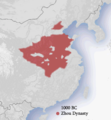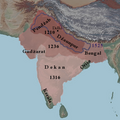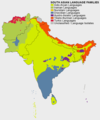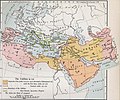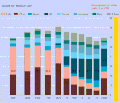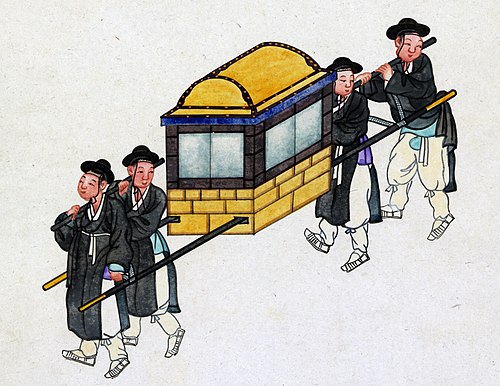Portal:Asia

 Asia (/ˈeɪʒə/ AY-zhə, UK also /ˈeɪʃə/ AY-shə) is the largest continent in the world by both land area and population. It covers an area of more than 44 million square kilometers, about 30% of Earth's total land area and 8% of Earth's total surface area. The continent, which has long been home to the majority of the human population, was the site of many of the first civilizations. Its 4.7 billion people constitute roughly 60% of the world's population. Asia shares the landmass of Eurasia with Europe, and of Afro-Eurasia with both Europe and Africa. In general terms, it is bounded on the east by the Pacific Ocean, on the south by the Indian Ocean, and on the north by the Arctic Ocean. The border of Asia with Europe is a historical and cultural construct, as there is no clear physical and geographical separation between them. A commonly accepted division places Asia to the east of the Suez Canal separating it from Africa; and to the east of the Turkish straits, the Ural Mountains and Ural River, and to the south of the Caucasus Mountains and the Caspian and Black seas, separating it from Europe. Since the concept of Asia derives from the term for the eastern region from a European perspective, Asia is the remaining vast area of Eurasia minus Europe. Therefore, Asia is a region where various independent cultures coexist rather than sharing a single culture, and the boundary between Europe is somewhat arbitrary and has moved since its first conception in classical antiquity. The division of Eurasia into two continents reflects East–West cultural differences, some of which vary on a spectrum. (Full article...) Featured articleBonshō (梵鐘, Buddhist bells), also known as tsurigane (釣り鐘, hanging bells) or ōgane (大鐘, great bells) are large bells found in Buddhist temples throughout Japan, used to summon the monks to prayer and to demarcate periods of time. Rather than containing a clapper, bonshō are struck from the outside, using either a handheld mallet or a beam suspended on ropes. The bells are usually made from bronze, using a form of expendable mould casting. They are typically augmented and ornamented with a variety of bosses, raised bands and inscriptions. The earliest of these bells in Japan date to around 600 CE, although the general design is of much earlier Chinese origin and shares some of the features seen in ancient Chinese bells. The bells' penetrating and pervasive tone carries over considerable distances, which led to their use as signals, timekeepers and alarms. In addition, the sound of the bell is thought to have supernatural properties; it is believed, for example, that it can be heard in the underworld. (Full article...) Selected Country Kazakhstan, officially the Republic of Kazakhstan, is a landlocked country primarily in Central Asia, with a small portion of its territory in Eastern Europe. It borders Russia to the north and west, China to the east, Kyrgyzstan to the southeast, Uzbekistan to the south, and Turkmenistan to the southwest, with a coastline along the Caspian Sea. Its capital is Astana, while the largest city and leading cultural and commercial hub is Almaty. Kazakhstan is the world's ninth-largest country by land area and the largest landlocked country. It has a population of 20 million and one of the lowest population densities in the world, at fewer than 6 people per square kilometre (16 people/sq mi). Ethnic Kazakhs constitute a majority, while ethnic Russians form a significant minority. Officially secular, Kazakhstan is a Muslim-majority country with a sizeable Christian community. Kazakhstan has been inhabited since the Paleolithic era. In antiquity, various nomadic Iranian peoples such as the Saka, Massagetae, and Scythians dominated the territory, with the Achaemenid Persian Empire expanding towards the southern region. Turkic nomads entered the region from as early as the sixth century. In the 13th century, the area was subjugated by the Mongol Empire under Genghis Khan. Following the disintegration of the Golden Horde in the 15th century, the Kazakh Khanate was established over an area roughly corresponding with modern Kazakhstan. By the 18th century, the Kazakh Khanate had fragmented into three jüz (tribal divisions), which were gradually absorbed and conquered by the Russian Empire; by the mid-19th century, all of Kazakhstan was nominally under Russian rule. Following the 1917 Russian Revolution and subsequent Russian Civil War, the territory was reorganized several times. In 1936, its modern borders were established with the formation of the Kazakh Soviet Socialist Republic within the Soviet Union. Kazakhstan was the last constituent republic of the Soviet Union to declare independence in 1991 during its dissolution. (Full article...) Featured biographyYao Ming (Chinese: 姚明; born September 12, 1980) is a Chinese basketball executive and former professional player. He played for the Shanghai Sharks of the Chinese Basketball Association (CBA) and the Houston Rockets of the National Basketball Association (NBA). Yao was selected to start for the Western Conference in the NBA All-Star Game eight times, and was named to the All-NBA Team five times. During his final season, he was the tallest active player in the NBA, at 7 feet 6 inches (2.29 m). Yao, who was born in Shanghai, started playing for the Sharks as a teenager, and played on their senior team for five years in the CBA, winning a championship in his final year. After negotiating with the CBA and the Sharks to secure his release, Yao was selected by the Rockets as the first overall pick in the 2002 NBA draft. He reached the NBA playoffs four times, and the Rockets won the first-round series in the 2009 postseason, their first playoff series victory since 1997. In July 2011, Yao announced his retirement from professional basketball because of a series of foot and ankle injuries which forced him to miss 250 games in his last six seasons. In eight seasons with the Rockets, Yao ranks sixth among franchise leaders in total points and total rebounds, and second in total blocks. (Full article...) General imagesThe following are images from various Asia-related articles on Wikipedia. Featured pictureA c. 1890 Korean illustration of a litter (gama in Korean), a type of human-powered transport, for the transport of persons. Gamas were primarily used by royalty and government officials, or in traditional weddings. Because of the difficulties posed by the mountainous terrain of the Korean Peninsula and the lack of paved roads, gamas were preferred over wheeled vehicles.
Did you know...
Updated: 6:33, 14 February 2024 In the news
Related portalsMajor Religions in Asia Middle East Central Asia and Caucasus Indian Subcontinent Southeast Asia East Asia Selected panorama
Birds and flowers of the four seasons (紙本墨画花鳥図, shihon bokuga kachōzu), part of the Paintings on room partitions in the abbot's quarters (hōjō) (方丈障壁画, hōjō shōhekiga) of Jukō-in (聚光院) of Daitoku-ji (大徳寺), Kyoto, Japan. Ink on paper. This picture shows four of 16 panels on fusuma (sliding doors) in the ritual room (室中). The paintings have been designated as National Treasures of Japan in the category paintings. TopicsCategoriesAssociated WikimediaThe following Wikimedia Foundation sister projects provide more on this subject:
More portalsShortcuts to this page: Asia portal • P:ASIA Purge server cache |




